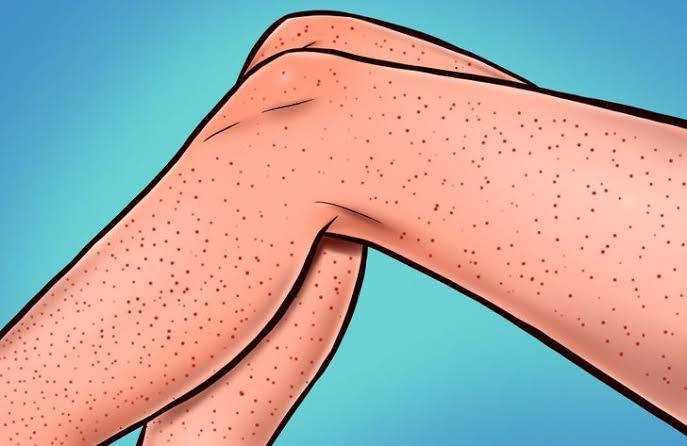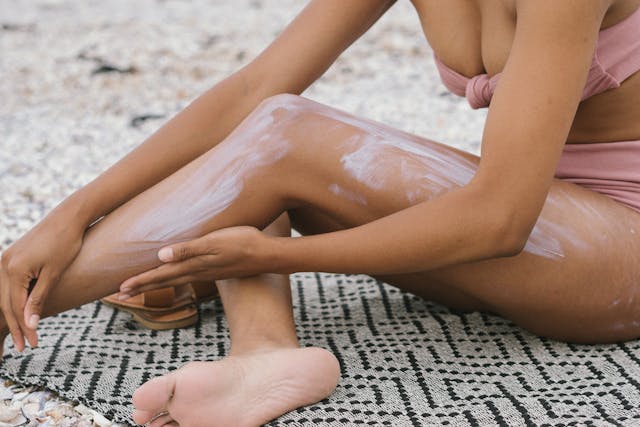
Strawberry legs refers to the appearance of spotty or pitted skin on the legs, which can occur for a variety of reasons. The little black bumps, which resemble strawberry seeds, are dirt, germs, or oil plugged skin pores and hair follicles. Fortunately, they are usually innocuous, and strawberry legs can be eliminated with a few changes to your shower and shaving routine.

Symptoms of Strawberry Legs
Strawberry legs are characterised by small black or red dots on your legs. The bumps might also be raised at times. They are normally painless and itchy. If you’re feeling painful skin irritation, it could be due to another skin problem.
Strawberry Legs: What Causes Them?
Strawberry legs are a symptom rather than a disease. Several different skin problems can produce them. Strawberry legs might form if your skin pores or hair follicles become clogged. Blackheads form when clogged pores or hair follicles, also known as comedones, are closed, giving the appearance of strawberry skin. The pore or follicle is open to the air when you open the comedones, such as shaving your legs. When air comes into contact with the oil, it oxidises and turns black.
Shaving
Shaving opens comedones, allowing debris, oil, and dead skin cells to be exposed to the air. Strawberry legs can occur when shaving with an old or dull blade. Razor burn, sometimes known as strawberry legs, is a common side effect. Folliculitis, an inflammation of the hair follicles, can also be caused by dry shaving or shaving with a dull blade.
Folliculitis
Folliculitis is an infection of the hair follicles in your skin. The lumps are normally small red bumps, although they might deepen and resemble strawberry legs. Damage to the hair follicle allows dirt and bacteria to enter, causing folliculitis. Shaving, waxing, wearing tight clothing, or touching the skin can all cause skin damage.
Pore Blockage
When the pores on your legs become clogged, your skin produces more oil naturally. The oil is exposed to air and turns black when you shave and open your pores. As a result, your legs are covered with small black spots. Strawberry legs are more likely to occur in those who have thicker hair or wider pores.
Excessively Dry Skin
Strawberry legs are not caused by very dry skin, but it does increase your risk. Dry skin is more sensitive, making it more prone to razor burn and irritation. Folliculitis and darker pores may result as a result of this. Furthermore, comedones appear when your skin is dry.
Treatment
To get rid of strawberry legs, concentrate on the source of the problem.
Shave with a moisturising cream.
After your hair and skin have been softened in the shower, shave. Skin irritation can be avoided by using a moisturising shaving cream. Wash your skin with a light soap or body wash to begin. Apply a layer of shaving cream after washing away debris and bacteria; search for labels that mention “for sensitive skin.” Any items with dyes or fragrances should be avoided.
Regularly exfoliate your skin
Exfoliate your skin on a regular basis to eliminate dead skin cells that can clog pores and hair follicles. Use a washcloth or loofah to gently exfoliate, then hydrate afterward.
Consistently moisturise your skin
To avoid dry skin and irritation, moisturise your skin on a regular basis. After showering, especially if you’ve just shaved, apply a little moisturiser. This will aid in the retention of moisture. Avoid any moisturisers that contain self-tanning lotion because they tend to accentuate the pitting.
Think about laser therapy.
Laser hair removal is becoming more popular as a professional, long-term hair removal alternative. Small amounts of radiation are delivered to hair follicles using lasers. Because the laser targets dark hues, it may be an excellent suit for someone with fair complexion and dark hair.
Prognosis
The sign of strawberry legs is the appearance of small black dots on your legs. Strawberry legs can be easily treated at home and with adjustments to one’s shaving or skincare routine for many people. The issue may require more intensive treatment in those with darker or thicker hair, larger pores, or darker skin pigmentation. Professional treatment is frequently the most effective and time-saving alternative.
Hope it helps!








